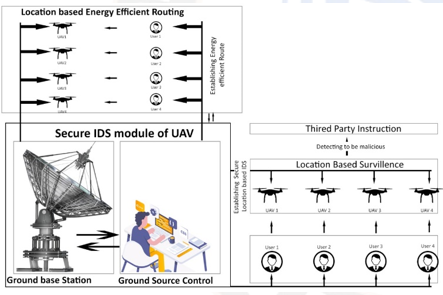Decentralized Machine Learning based Energy Efficient Routing and Intrusion Detection in Unmanned Aerial Network (UAV)
Main Article Content
Abstract
Decentralized machine learning (FL) is a system that uses federated learning (FL). Without disclosing locally stored sensitive information, FL enables multiple clients to work together to solve conventional distributed ML problems coordinated by a central server. In order to classify FLs, this research relies heavily on machine learning and deep learning techniques. The next generation of wireless networks is anticipated to incorporate unmanned aerial vehicles (UAVs) like drones into both civilian and military applications. The use of artificial intelligence (AI), and more specifically machine learning (ML) methods, to enhance the intelligence of UAV networks is desirable and necessary for the aforementioned uses. Unfortunately, most existing FL paradigms are still centralized, with a singular entity accountable for network-wide ML model aggregation and fusion. This is inappropriate for UAV networks, which frequently feature unreliable nodes and connections, and provides a possible single point of failure. There are many challenges by using high mobility of UAVs, of loss of packet frequent and difficulties in the UAV between the weak links, which affect the reliability while delivering data. An earlier UAV failure is happened by the unbalanced conception of energy and lifetime of the network is decreased; this will accelerate consequently in the overall network. In this paper, we focused mainly on the technique of security while maintaining UAV network in surveillance context, all information collected from different kinds of sources. The trust policies are based on peer-to-peer information which is confirmed by UAV network. A pre-shared UAV list or used by asymmetric encryption security in the proposal system. The wrong information can be identified when the UAV the network is hijacked physically by using this proposed technique. To provide secure routing path by using Secure Location with Intrusion Detection System (SLIDS) and conservation of energy-based prediction of link breakage done by location-based energy efficient routing (LEER) for discovering path of degree connectivity. Thus, the proposed novel architecture is named as Decentralized Federate Learning- Secure Location with Intrusion Detection System (DFL-SLIDS), which achieves 98% of routing overhead, 93% of end-to-end delay, 92% of energy efficiency, 86.4% of PDR and 97% of throughput.
Article Details
References
B. Brik, A. Ksentini, and M. Bouaziz, “Federated learning for UAVsenabled wireless networks: Use cases, challenges, and open problems,” IEEE ACCESS, vol. 8, pp. 53841-53849, 2020.
B. McMahan, E. Moore, D. Ramage, S. Hampson, and B. A. Arcas, “Communication-efficient learning of deep networks from decentralized data,” in Proc. AISTATS, pp. 1273-1282, 2017.
S. Samarakoon, M. Bennis, W. Saad, and M. Debbah, “Federated learning for ultra-reliable low-latency V2V communications,” in Proc. IEEE GLOBECOM, pp. 1-7, 2018.
M. Chen, H. V. Poor, W. Saad, and S. Cui, “Wireless communications for collaborative federated learning,” IEEE Communications Magazine, vol. 58, no. 12, pp. 48-54, 2020.
P. Pinyoanuntapong, P. Janakaraj, P. Wang, M. Lee, and C. Chen, “FedAir: Towards multi-hop federated learning over-the-air,” in Proc. IEEE SPAWC, pp. 1-5, 2020.
S. Hosseinalipour, C. G. Brinton, V. Aggarwal, H. Dai, and M. Chiang, “From federated to fog learning: Distributed machine learning over heterogeneous wireless networks,” IEEE Communications Magazine, vol. 58, no. 12, pp. 41-47, 2020.
T. Zeng, O. Semiari, M. Mozaffari, M. Chen, W. Saad, and M. Bennis, “Federated learning in the sky: Joint power allocation and scheduling with UAV swarms,” in Proc. IEEE ICC, pp. 1-6, 2020.
S. S. Ram, A. Nedic, and V. V. Veeravalli, “Asynchronous gossip algorithms for stochastic optimization,” in Proc. IEEE CDC, pp. 3581- 3586, 2009.
A. Nedic and A. E. Ozdaglar, “Distributed subgradient methods for multi-agent optimization,” IEEE Transactions on Automatic Control, vol. 54, no. 1, pp. 48-61, 2009.
X. Lian, C. Zhang, H. Zhang, C.-J. Hsieh, W. Zhang, and J. Liu, “Can decentralized algorithms outperform centralized algorithms? A case study for decentralized parallel stochastic gradient descent,” in Proc. NIPS, pp. 5330-5340, 2017.
Z. Tang, S. Shi, and X. Chu, “Communication-efficient decentralized learning with sparsification and adaptive peer selection,” in Proc. IEEE ICDCS, pp. 1207-1208, 2020.
M. Chen, Z. Yang, W. Saad, C. Yin, H. V. Poor, and S. Cui, “A joint learning and communications framework for federated learning over wireless networks,” IEEE Transactions on Wireless Communications, vol. 20, no. 1, pp. 269-283, 2021.
N. H. Tran, W. Bao, A. Y. Zomaya, M. N. H. Nguren, and C. S. Hong, “Federated learning over wireless networks: Optimization model design and analysis,” in Proc. IEEE INFOCOM, pp. 1387-1395, 2019.
J. Ren, G. Yu, and G. Ding, “Accelerating DNN training in wireless federated edge learning systems,” IEEE Journal on Selected Areas in Communications, vol. 39, no. 1, pp. 219-232, 2021
Wasswa Shafik et al., “A reawakening of Machine Learning Application in Unmanned Aerial Vehicle: Future Research Motivation,” EAI Endorsed Transactions on Internet of Things, Volume 8 Issue 29, 2022
Rolly RM, Malarvezhi P, Lagkas TD. Unmanned aerial vehicles: Applications, techniques, and challenges as aerial base stations. International Journal of Distributed Sensor Networks. 2022;18(9). doi:10.1177/15501329221123933
Pham, Q. V., Zeng, M., Ruby, R., Huynh-The, T., & Hwang, W. J. (2021). UAV communications for sustainable federated learning. IEEE Transactions on Vehicular Technology, 70(4), 3944-3948.
Yang, H., Zhao, J., Xiong, Z., Lam, K. Y., Sun, S., & Xiao, L. (2021). Privacy-preserving federated learning for UAV-enabled networks: learning-based joint scheduling and resource management. IEEE Journal on Selected Areas in Communications, 39(10), 3144-3159.
Chhikara, P., Tekchandani, R., Kumar, N., Guizani, M., & Hassan, M. M. (2021). Federated learning and autonomous UAVs for hazardous zone detection and AQI prediction in IoT environment. IEEE Internet of Things Journal, 8(20), 15456-15467.
Khan, A. A., Khan, M. M., Khan, K. M., Arshad, J., & Ahmad, F. (2021). A blockchain-based decentralized machine learning framework for collaborative intrusion detection within UAVs. Computer Networks, 196, 108217.
Mrad, I., Samara, L., Abdellatif, A. A., Al-Abbasi, A., Hamila, R., & Erbad, A. (2021). Federated Learning for UAV Swarms Under Class Imbalance and Power Consumption Constraints. arXiv preprint arXiv:2108.10748.

